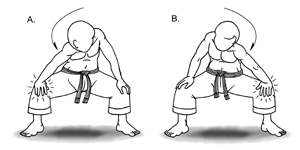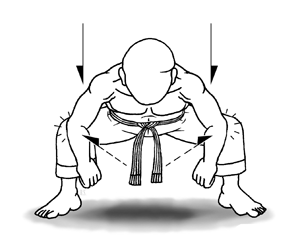"Lift things properly, hit things with care" - Mike Clarke
The above maxim should be at the forefront of your mind when embarking upon the study of traditional Okinawan hojo undo. Find your limit with each tool and exercise, and then carefully and methodically push that limit further and further. In doing so you will learn much about yourself and who you really are.
The following warming-up exercises or junbi undo are preparation exercises, see also Part 1 for additional exercises (1 through 3) and for ways of focusing the mind on a particular part of the body.

Junbi-Undo 4—Place the feet together with the heels touching and the toes apart making a V-shape with the feet (musubi dachi). Leaning forward, the hands are placed on the knees, where a little pressure is brought to bear to push them backward (Figure A). At this point, be sure the toes, especially the big toe, stay firmly on the ground, gripping the floor. The big toe provides us with the ability to balance properly, and a strong connection to the ground with this particular digit is therefore essential.
Bend the knees and drop the body down into a squatting position, keeping the back straight and the knees out to the sides as the heels leave the floor (Figure B). Remain in this posture for a few seconds before returning to the starting position. The bending and standing is repeated at least ten times, and care should be taken not to overextend the knee joint by dropping too quickly into the squat. The hands remain on the knees throughout.

Junbi-Undo 5—On the final squat, hold for at least thirty seconds. Push the knees open and back, and keep the back straight: now close your eyes. After thirty seconds, open your eyes and stand up. This exercise helps develop balance while strengthening the toes and is exactly the posture (stance) required in the Goju ryu kata kururunfa. Toward the end of the kata, a 180-degree turn is performed bringing the karateka into musubi dachi (V-shaped stance) before dropping immediately into koshi dachi (squatting stance—standing on the balls of the feet). In the kata, this stance facilitates a throwing technique.
Shiko dachi—low stance
When moving in shiko dachi (low stance), it is important not to lean with the shoulders first or to simply spin one leg around the other. Although there are some occasions where a spin is used, it is specific to the techniques being performed. Moving incorrectly in relation to the technique we are trying to do takes away control and the loss of control hinders our ability to affect the outcome properly, as well as the opportunity to adapt should the need arise. In this case, the body should remain upright while the weight transfer is taken care of by the legs when the “stepping” leg pushes the weight onto the “standing” leg before moving quickly to its next location.
The result of moving from one posture to another, regardless of which method is being employed, should be predictable and never left to chance. Along with poor control of our body comes a diminished ability to control someone else. It is important to remember that at the core of karate training is the challenge to control ourselves first. This speaks to our mind as well as our body and perhaps sheds light on why complete mastery of karate is an achievement accomplished by so few.

Junbi-Undo 6—Step out into shiko dachi (low stance) and place the hands on the inside of the thighs close to the knees. Drop the right shoulder forward, turn the head gently, and look to the left (Figure A). The right arm now pushes the right leg backward while the left arm checks the left leg from moving forward. Again, take care to keep the toes of both feet firmly gripping the floor throughout this exercise.
The stretch should be felt along the top of the inner thigh and should be held for several seconds before switching over and repeating on the opposite side of the body (Figure B).

Junbi-Undo 7—Staying in shiko dachi, run both forearms down the inside of the legs until the elbows are slightly above the knees. Bring an equal pressure to bear on both legs to push them apart. With the toes gripping the floor, hold the chest up, as upright as possible, to maximize the stretch on the legs. Hold for at least ten seconds.
A timely reminder here—all stretches should be done with care and never rushed. Regardless of how flexible you might be, never drop into or come out of a stretch quickly. Always perform these actions slowly and methodically, and take care of your body.

Junbi-Undo 8—Lean onto the right leg and keep the left leg stretched out, with the foot and toes flat on the ground (Figure A). Rest the hands on the knees and try to maintain an image of the calf muscles being stretched by your posture. Without raising the body, move across onto the opposite leg, not by leaning, but by isolating the leg muscles and making the bent leg move the weight of the body across to the other side in as level a manner as possible. The idea is to recognize the exchange of your body weight from one leg to the other. This “feeling” is necessary in many Goju ryu kata, but particularly so in the kata seiyunchin. Hold the posture on either side for several seconds before moving back across in a steady manner. Ten repetitions on both sides gives the legs a good workout.
Moving directly on from the previous exercises and into this one, drop the body down into a lower (squatting) position and allow the foot of the outstretched leg to rest on the heel with the toes pointing upward, while keeping the foot of the squatting leg flat on the floor (Figure B). The stretch has moved now from the lower leg to the upper leg and with the lower center of gravity now involved, the feeling of transferring your weight increases; doing the exercise correctly strengthens the legs.



